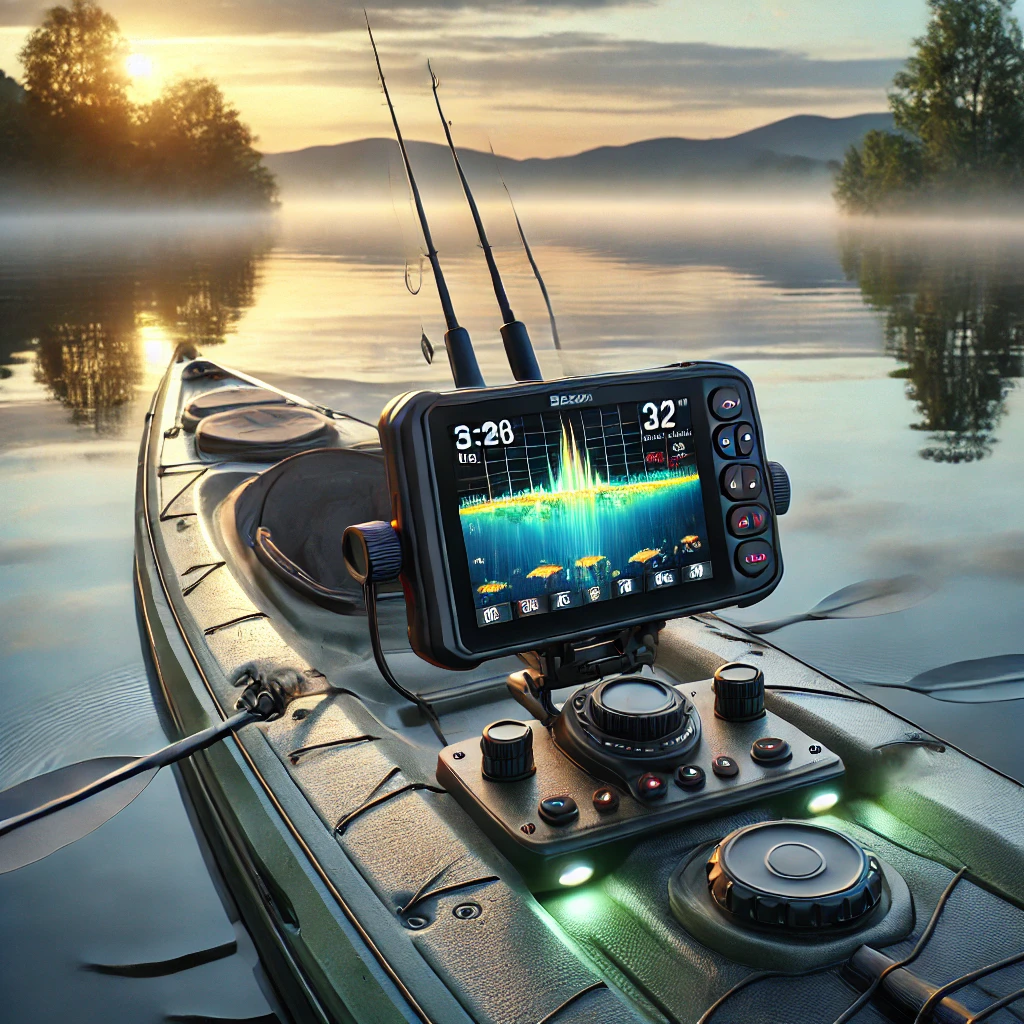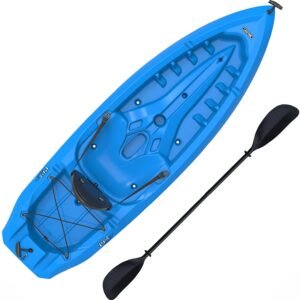Looking for a review of the best kayak fish finders? You have come to the right place!
Kayak fishing becomes more and more popular. Among the reasons for its increasing popularity are exercise, affordability, and the healthy excitement of fishing. Try fishing from a kayak once, and you will very likely fall in love with it!
If you already have a fishing kayak and want to start fishing, you need one more piece of equipment – a fish finder. Below, we’ll have a look at the best kayak fish finders to help you choose the right kayak fish finder for your needs!
A fish finder emits sonar waves into the water to hopefully detect fish. When the waves hit something – like fish, rocks, or the bottom – they get reflected back into the fish finder. Since fish and objects affect the waves differently, you are able to identify them on the screen of the fish finder.
A fish finder thus is a very useful addition to your angling arsenal. You don’t necessarily need to use a fish finder to have a good catch, but it will make things way easier for you.
Using kayak fish finders enhances your fishing experience by allowing you to locate fish efficiently. The right kayak fish finder can make a significant difference in your catch rates, especially in unfamiliar waters.
Table of Contents
What To Look For In The Best Kayak Fish Finder
Before moving on to our reviews, let’s try to understand what to look for when shopping for the best kayak fish finder. Our guide will allow you to better understand our top picks and will help you going forward.
Investing in a quality kayak fish finder can be a game changer. The right features can improve your fishing strategy, making your time on the water more enjoyable and productive.
Water depth
When it comes to water depth, you should pay attention to the imaging technology of the fish finder.
For shallow depths, a side-imaging unit would be more than enough. However, for fish species that like to dwell at greater depths, strongly consider a down-imaging unit. A down-imaging fish finder is much better at displaying motion in deep water.
Aside from technology, also pay attention to the advertised maximum depth. Fish finder brands often overstate their devices’ maximum depth, but it’s a useful number to consider.
Frequencies & beam angle
With frequencies, you need to know that low frequencies penetrate the water better, but they don’t allow you to see a high level of detail. For example, you won’t see individual fish at high depth with a low-frequency fish finder.
Low-frequency fish finders (usually about 50 kHz) are the best at measuring the shape or structure of the bottom, which is critical for localizing fish. The beam angle of 50 kHz fish finders is typically 45 to 50 degrees as well, which allows for a wider area of coverage.
On the other hand, high frequencies (typically about 200 kHz) don’t pass through water that well, but they allow you to pinpoint fish. The beam angle of high-frequency fish finders is usually 12 to 15 degrees, and it is precisely thanks to the narrow beam that high-frequency fish finders allow you to have a more detailed look into the water.
Some fish finders support two or even more frequencies, while others can work only with one. Multi-band fish finders are more expensive, but they do allow you to see far into the water in high detail.
Target separation
Remember, choosing a kayak fish finder is about finding the right balance of features that will enhance your kayak fishing experience while staying within your budget.
Some fish finder brands also list target separation. This spec shows the minimum distance between two objects required by the fish finder for separation. A fish finder with 0.5 inches of target separation will be able to distinguish smaller objects than a fish finder with 1 inch of target separation.
GPS capability
GPS is a must if you are going to wander off far from the shore. A GPS-compatible fish finder allows you to create routes, set waypoints, and do other things to facilitate navigation.
Many kayak fish finders also come equipped with GPS capabilities, allowing you to mark your favorite fishing spots and navigate efficiently on the water.
GPS is a really nice feature to have even if you aren’t going to travel too far, but if your budget is limited and you don’t need to keep track of your visited places or whatnot, don’t waste money on it.
Power source
Kayak owners should get a battery-powered fish finder. Unfortunately, not every fish finder out there can operate from a battery – most are intended to be hooked to a 12V power source, which your kayak probably doesn’t have.
With batteries, you also need to pay attention to battery life – the longer, the better. You would also want batteries that charge quicker.
Display
When it comes to the display, there are three things to pay attention to:
- Backlighting. Backlit fish finder displays stay visible in low light. Not everybody will benefit from a backlit display, but it’s a great feature to have.
- Display size. A large display makes reading info easier. But on the other hand, a fish finder with a large display gets bulky and heavy, which may be undesirable for some people. You’ll need to find the right balance of display size and bulkiness yourself.
- Display resolution. High-resolutiondisplays do a better job of showing fine detail. You don’t really need high resolution to see the output of your fish finder, but very low resolutions should be avoided.
Kayak compatibility & mounting
Last but not least, you may want to check if your kayak is even compatible with fish finders.
It’s no problem if your kayak isn’t equipped for a fish finder – you could always DIY your way around the issue and still be able to find a lot of fish. You may secure the fish finder inside your kayak with tape, and it would work fine with minimal signal loss.
But if your kayak has mounting points for a fish finder, your life is going to become much easier.
Some fish finders have castable transducers. These transducers are intended to be thrown into the water – you then view the scan readings on the fish finder display or a smartphone app. Such fish finders don’t require any mounting points in your kayak.
The nice thing about castable fish finders is that they allow you to analyze the water at a distance, whereas trolling or mountable fish finders can only show you what’s happening right under the kayak. This can be super-useful when you are casting the lure really far.
In case you are shopping for a kayak right now, make sure that what you get will work with a fish finder. Some kayaks have mounting rails, while others have scuppers that can accept fish finder transducers.
Top 5 Best Kayak Fish Finders for Every Angler
HawkEye Fishtrax 1C Fish Finder
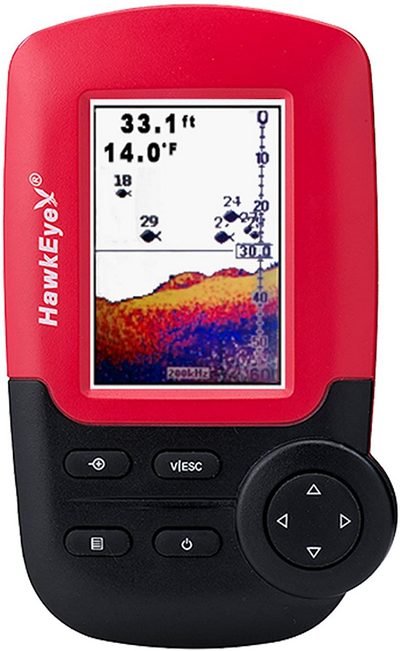
The HawkEye Fishtrax 1C fish finder is a great option if you are looking for something inexpensive.
Aside from that, Fishtrax 1C is excellent for identifying small details in the water thanks to its narrow beam angle (14 degrees) and 200 kHz frequency. You may also switch to the lower 83 kHz frequency to identify fast-moving fish in deeper water.
The Fishtrax 1C fish finder can switch between frequency modes automatically, which is really convenient. You may adjust the sensitivity to tweak the accuracy as well, and the auto-zoom ground tracking allows you to waste less time on adjusting the fish finder.
Upon identifying fish in the water, Fishtrax 1C sounds an alarm, although the fish finder isn’t always accurate at pinpointing fish. Fishtrax 1C may sometimes give false positives if it detects something shaped and sized like fish.
The maximum depth of Fishtrax 1C is advertised at 240 feet, by the way.
This Fish Finder has a number of modes as well – Fish Finder, Data, and Ice-Mode Digital Flasher. The Flasher shows real-time info on what’s happening beneath you, while Fish Finder returns historical data.
What’s also nice about Fishtrax 1C is that it runs on 4 AAA batteries, so you will be able to use it even if your kayak doesn’t have 12V power. Most kayaks don’t have a power source anyway.
Fishtrax 1C may also be trolled, mounted to the vessel, or thrown into the water to produce readings. The backlit display is a super-nice feature as well since it allows you to view readings in low light.
Deeper PRO Smart Portable Sonar
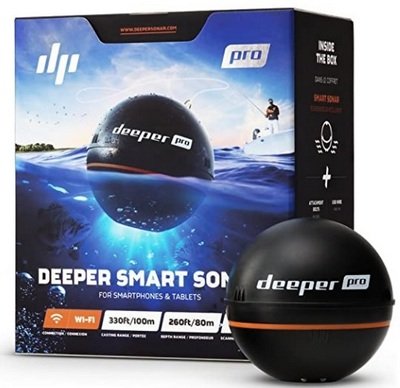
The Deeper Pro Smart portable sonar is remarkable in that it’s intended to connect to your smartphone to transfer data. You toss the Deeper fish finder into the water, connect to it via Wi-Fi, and get readings straight to your mobile device.
Deeper Pro can send data at up to 330 feet, but you should obviously stay closer to the fish finder to get better signal quality.
When it comes to fish-finding capabilities, the Deeper Pro sonar is also nice. It detects objects and fish at depths between 2 and 260 feet with a target separation of 1 inch, and it also has two frequency modes. The wide 55-degree beam at 90 kHz allows you to scan broad areas, while the narrow 15-degree mode at 290 kHz works wonderfully for detailed scanning.
The Deeper Pro portable sonar is also capable of creating bathymetric maps while you are on the shore, and it also automatically saves scans to the cloud via the Fish Deeper app.
Deeper Chirp Portable Fish Finder
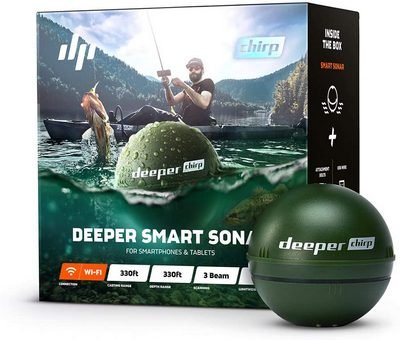
Priced slightly higher than Deeper Pro, the Deeper Chirp portable fish finder offers even higher accuracy and detail in the water.
The highlight of the Chirp fish finder is the three scanning cones/angle modes. Chirp’s modes are 100 kHz at 47 degrees, 290 kHz at 16 degrees, and 675 kHz at 7 degrees. The target separation in the Chirp is also better – down to 0.4 inches.
Chirp can detect objects and fish at greater depths as well – 330 feet versus Pro’s “measly” 260 feet.
Other than the increased accuracy, Chirp is identical to the Pro portable fish finder. Most importantly, you may again cast it into the water, connect it to your smartphone via the Fish Deeper app, and keep an eye on fish at a distance.
Deeper Start Smart Fish Finder
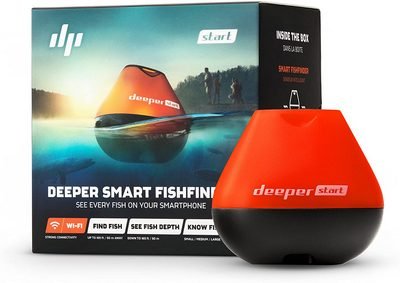
If you liked the concept of the Deeper Pro and Deeper Chirp sonars but don’t have the budget, then consider Deeper Start. The Start smart fish finder lacks the accuracy and features of its bigger brothers, but it’s a good choice if your pocket isn’t deep.
Deeper Start mainly differs from Chirp and Pro in accuracy and range. This fish finder has a casting and scanning depth range of only 165 feet, and the target separation is also down to 2 inches – noticeably weaker than in the higher-end Deeper fish finders.
There is only one frequency mode as well – 120 kHz with a 40-degree beam.
The temperature resistance of this fish finder is weaker too – from 32 to 104 degrees Fahrenheit, whereas the other two fish finders are designed to withstand -4 to 104 degrees. So no ice fishing with the Deeper Start.
Other than that, the Deeper Start, like its bigger brothers, allows you to scan the water remotely via your smartphone. If you don’t need super-good accuracy, Start should be a great buy.
Check Price
Once you’ve selected the best kayak fish finder for your needs, you’ll find that it opens up a whole new world of fishing possibilities, allowing you to locate fish more easily and efficiently.
Garmin STRIKER Plus 7cv Fish Finder
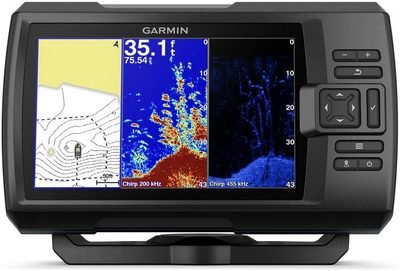
The Garmin STRIKER Plus 7cv fish finder is a great pick if you want something more serious. This thing boasts a built-in GPS-receiver and a color display with a resolution of 800 x 480 pixels. The display is particularly notable due to how much it increases readability.
To scan water bodies, the 7cv fish finder features the Garmin CHIRP traditional sonar with three frequency modes – 50, 77, and 200 kHz. Additionally, this fish finder comes with the CHIRP ClearVü sonar with 260, 455, and 800 kHz modes. The ClearVü technology delivers more detail for underwater objects and fish.
The Garmin STRIKER Plus 7cv fish finder also allows you to mark successful fishing spots. You may additionally exchange data with other models from the STRIKER and echoMAP series, as well as quickly generate fishing maps thanks to the Quickdraw Contours software. The fish finder can store up to 2 million acres of maps too!
Final Words on the Best Kayak Fish Finders
Some may think of fish finders as follows – give an angler a fish finder, and fishing will no longer make sense.
For a fisherman who knows an area well, a fish finder may indeed be a waste of money. But if you are going to explore an unfamiliar area or a new route, a fish finder could help you tremendously.
A fish finder lets you know in a matter of seconds what is going on at the bottom and whether or not fish is present. Without a fish finder, you may have to spend hours trying to find a good spot. In our opinion, the time savings certainly make fish finders worth the money.
